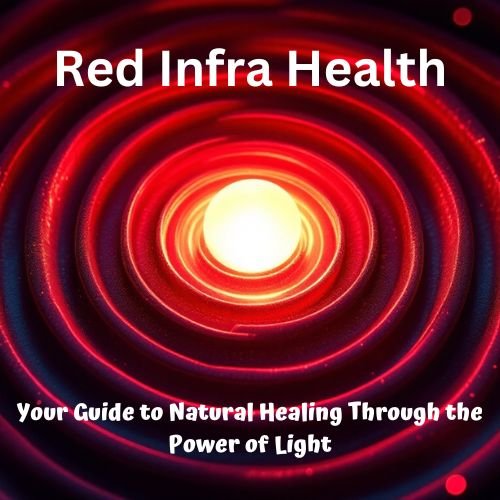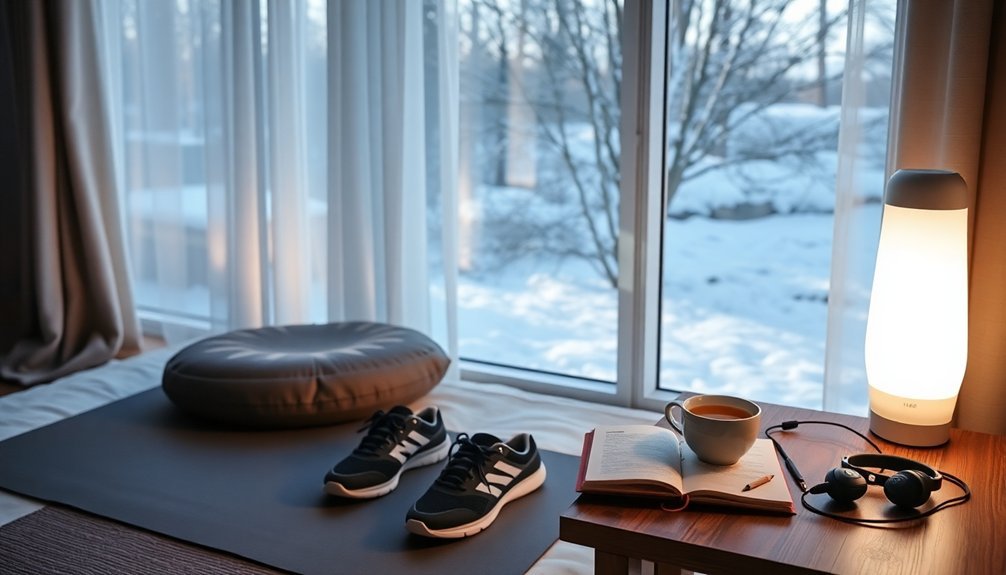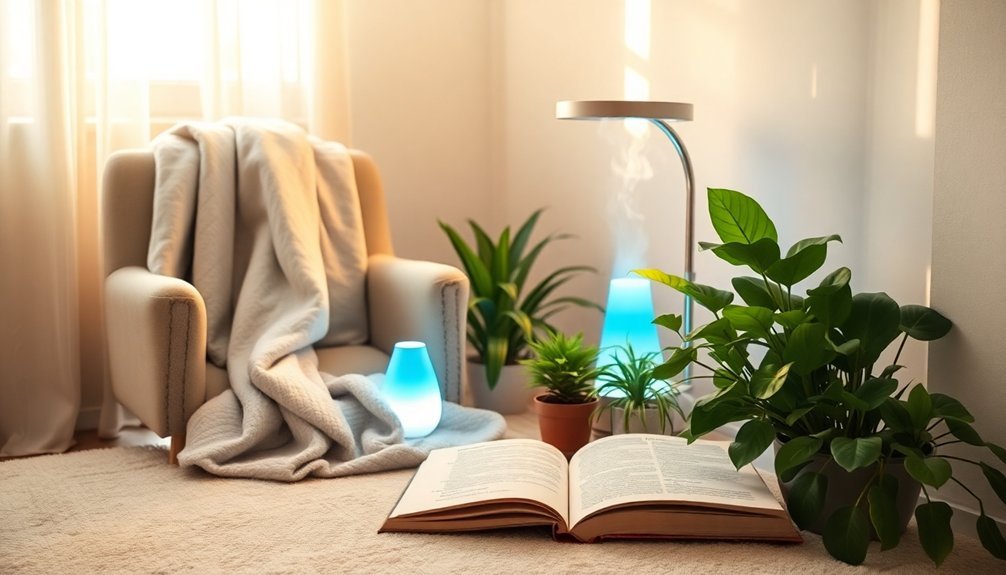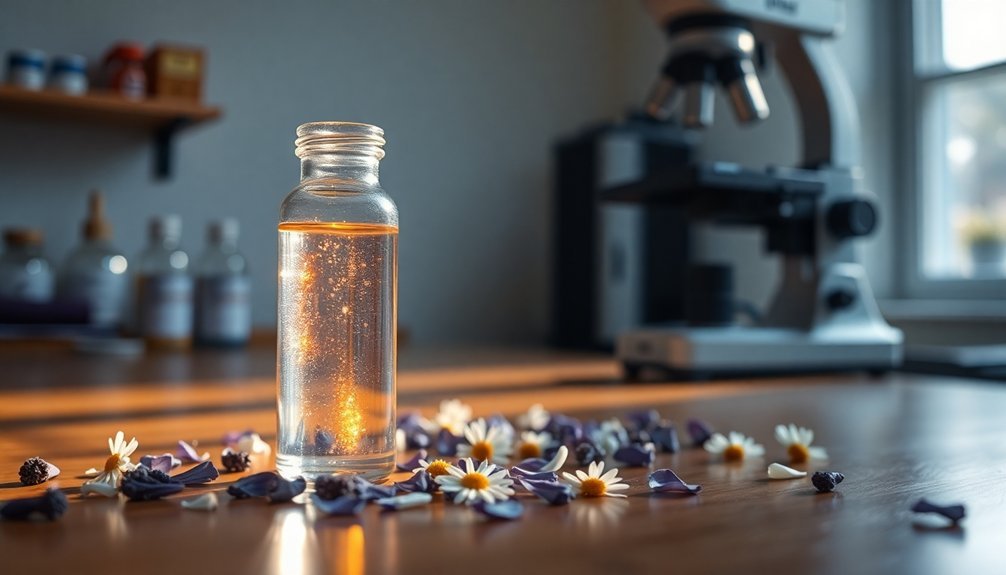You'll get better results treating Seasonal Affective Disorder (SAD) when you combine multiple proven therapies instead of relying on just one approach. Start light therapy early in fall using a 10,000-lux light box for morning sessions. Mix your light therapy with exercise, like placing the box near workout equipment or taking morning walks. Create a consistent schedule that coordinates light therapy with other treatments like CBT-SAD or medication. Keep your living space bright by maximizing natural light and using lighter colors. Balance artificial light treatment with natural sunlight exposure whenever possible. These strategic combinations can substantially boost your mood during darker months.
Start Light Therapy Early

Feeling the winter blues creeping in? Don't wait until winter hits to start your light therapy routine. Begin your treatment in early fall, ideally by late October or November, to get ahead of Seasonal Affective Disorder (SAD) symptoms.
You'll need a 10,000 lux light box, which should be placed 12-18 inches from your face for the best results. Make sure your light filters out UV rays and comes with adjustable brightness settings.
Plan for 30-minute sessions each morning, as morning light therapy typically works better than evening exposure due to its effects on your circadian rhythm. Research shows that females are more affected by SAD than males, making early intervention particularly important for women.
Set yourself up for success by choosing a light box with a timer, and position it where you'll naturally spend time in the morning, like your breakfast table or desk. You'll want to continue your therapy until spring, especially if you live in higher latitudes where natural daylight is scarce.
While light therapy works well on its own, you might consider combining it with vitamin D supplements, psychotherapy, or antidepressants for enhanced results. Remember to evaluate your SAD symptoms and consult with a healthcare provider to create the most effective treatment plan for your needs.
Mix Light With Movement
A powerful way to boost your SAD treatment is combining light therapy with physical activity. Research shows that just 30 minutes of moderate exercise alongside light exposure can substantially enhance your mood and reduce SAD symptoms more effectively than using either treatment alone.
You can integrate these therapies by placing your light therapy box near your exercise equipment or using portable light devices during morning walks. This approach delivers the recommended 10,000 lux intensity while staying active. If you're exercising indoors, position yourself near a window or light therapy source while you move.
For outdoor activities, try scheduling your walks or runs during the early morning hours to maximize natural light exposure.
Consider starting with a morning routine that combines both therapies. You'll get the dual benefits of regulating your circadian rhythms while improving your overall mental health.
Monitor how different combinations affect you – some people find better results with indoor stationary exercises near a light box, while others prefer outdoor morning activities with portable light devices.
Remember to maintain consistency with both treatments and adjust light intensity based on your activity level. Clinical studies confirm that this combined approach can lead to better and more sustained symptom relief than single therapies alone.
Coordinate Multiple Treatment Times

While combining light and movement offers powerful benefits, coordinating multiple SAD treatments throughout your day can maximize their effectiveness. Start by creating a consistent schedule that incorporates light therapy, CBT-SAD sessions, and any prescribed medications at ideal times.
You'll want to begin these treatments before your typical SAD season starts to prevent symptom onset. The condition affects many people for five months annually, so maintaining your treatment schedule through winter is crucial.
Work with your healthcare provider to develop a personalized treatment plan that fits your daily routine. If you're taking antidepressants, time them appropriately with light therapy sessions and consider any potential interactions with supplements like vitamin D.
Schedule your light therapy at the same time each day to help regulate your body's natural rhythms.
Don't forget to include behavioral activation in your schedule – plan enjoyable activities and social interactions that can complement your formal treatments.
Regular follow-up appointments with your healthcare provider will help monitor your progress and adjust your treatment timing as needed. Remember that flexibility is key; you may need to modify your treatment schedule as seasons change and your symptoms evolve.
Stay committed to your coordinated treatment plan throughout the entire seasonal period to maintain improvements and prevent relapse.
Brighten Your Living Space
Sunlight streaming through windows can substantially boost your mood during darker months. To maximize natural light, keep your curtains and blinds open during daylight hours, and opt for lighter window treatments instead of heavy drapes. You'll want to clean your windows regularly to guarantee maximal light transmission, and if possible, consider installing skylights or larger windows to increase natural light exposure. Light exposure helps regulate serotonin levels that affect your mood.
Transform your space with mood-boosting colors by incorporating warm yellows, oranges, and light blues.
Paint your walls in lighter shades to reflect and amplify available light, and add bright accents through furniture and decor pieces.
Don't forget to create cozy corners throughout your home using soft furnishings like plush cushions, warm blankets, and comfortable rugs.
Designate specific areas for different activities to maintain a balanced lifestyle. Set up a dedicated exercise space to encourage physical activity, and create separate zones for relaxation.
Keep your environment clutter-free to reduce stress, and add personal touches like artwork and indoor plants to enhance your connection with the space.
Using ergonomic furniture will support your physical well-being while you spend time indoors.
Balance Natural And Artificial Light

Light mastery plays a crucial role in managing Seasonal Affective Disorder effectively. You'll want to combine both natural and artificial light exposure to maximize your relief from SAD symptoms.
Start your day with a morning walk outdoors for about an hour, as this helps regulate your melatonin secretion and can lead to significant improvement in your condition.
Complement your natural light exposure with artificial light therapy using a 10,000-lux light box for 30-45 minutes each morning. This combination approach helps regulate your mood, sleep patterns, and appetite by modulating both serotonin and melatonin levels.
You'll need to maintain consistency with both approaches throughout the darker months to sustain the benefits.
Remember to adjust your light exposure based on your individual response and seasonal changes. If you're using light therapy, make certain you're under medical supervision, especially if you have eye conditions.
You might also consider supplementing your light treatment with vitamin D and other therapies like medication or counseling if recommended by your healthcare provider. The key is finding the right balance between natural and artificial light that works best for your specific needs.
Frequently Asked Questions
Can Light Therapy Cause Eye Damage or Vision Problems?
Yes, light therapy can harm your eyes. You're at risk for retinal damage, especially from blue light exposure. If you're over 40, taking certain medications, or have eye conditions, you're particularly vulnerable.
How Do Medications Interact With Light Therapy During Different Times?
You'll get the best results when you take antidepressants and use light therapy in the morning. It's important to follow your doctor's timing recommendations, as some medications may affect your sensitivity to light.
Which Antidepressants Work Best When Combined With Light Therapy?
You'll find SSRIs, especially fluoxetine, work best with light therapy. They've shown strong results when combined, but you should start taking them before winter symptoms appear for maximum effectiveness.
Should Light Therapy Be Adjusted Based on Seasonal Changes?
Yes, you'll need to adjust your light therapy based on seasonal changes. In winter, focus on morning sessions, while in summer, you might need reduced exposure. Always modify intensity and timing to match your body's needs.
Are There Specific Foods That Enhance the Effectiveness of SAD Treatments?
You'll boost your SAD treatment by eating foods rich in omega-3s, vitamin D, and B-12. Include salmon, whole grains, berries, and leafy greens. These nutrients support serotonin production and improve mood.
In Summary
You'll find relief from seasonal affective disorder by combining different therapeutic approaches thoughtfully. Start your light therapy sessions in early fall, pair them with exercise, and coordinate your treatments effectively throughout the day. Don't forget to maximize natural light in your home while supplementing with artificial sources. When you're strategic about mixing these methods, you'll create a powerful defense against winter blues.





Leave a Reply